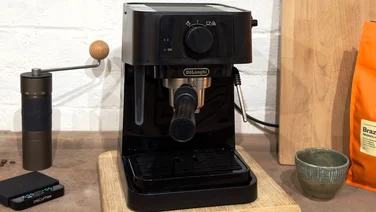To help us provide you with free impartial advice, we may earn a commission if you buy through links on our site. Learn more









- Gorgeous looks and build quality
- Capable of producing sublime coffee
- Superb design
- Expensive
If you demand perfection from every cup of coffee, you need an espresso machine that’s capable of the task; a coffee machine that gives you the ultimate flexibility and the ability to deliver a consistently high quality. Sage’s The Dual Boiler is exactly that. This high-end machine is the home barista equivalent of the professional-class machines you see in proper coffee shops – it’s purpose-built to brew perfect coffee time after time.
With its all-metal body, pressure dial and LCD display, this is a machine that screams quality. Available in red, black and silver, it doesn’t just feel well built, it also looks stunning. This is the kind of machine that you’d be proud to have as the centrepiece of your kitchen.









More than looking the part, just looking down the specs sheet shows The Dual Boiler seems to have everything that anyone serious about their coffee could want. Top of that list, as the name explains, is the dual boiler, which means that this machine has one boiler ready to run at espresso temperature, and one ready for steam. With no heat up (or cool down) phase required, you can very quickly prepare milk-based drinks without losing temperature, which is a problem with typical home manual machines. Next, as well as its steam wand, controlled by a tap on the side, there’s a tap for on-demand hot water, letting you make longer drinks or for pre-warming cups and the group handle.
Sage The Dual Boiler review: Setup and bundled accessories
Sage bundles absolutely everything that you could possibly need to make decent coffee. It ships with four 58mm filter baskets that clip securely into the tough industrial group handle. There are filters for single and double shots of espresso, which come in single and dual-wall varieties. The single wall filters are designed to be used with coffee that you grind yourself, as you can adjust the grind to suit the machine; the dual wall filters are designed to be used with pre-ground coffee, evening out pressure and flow to create excellent espresso where you have no control over the grind.
On top of that, you get a milk jug, for frothing and steaming, and a tamper that perfectly fits inside the filters, and can be magnetically attached to the machine, letting you tamp by pressing the group handle up against it. You also get the Razor: a business-card-shaped sheet of metal with a bevelled edge, that you can use to level off your coffee grounds in the filter to get even results.
Before you get started making coffee, there are a few set-up phases that you need to go through. First, you need to use the water hardness strip to test your water so that you can set the machine accordingly. Next, you have to fit the water filter into the large 2L tank and insert it into the back of the machine (filling afterwards can be down by pouring water through the top spout, hidden under a pop-up lid). Finally, you have to prepare the machine and flush some water through it. It’s a little more involved than most machines, but the manual makes it easy to follow the procedure and ensures that your machine is set up to deliver the best quality coffee.
Sage The Dual Boiler review: Making espresso
Making an espresso with The Dual Boiler is practically the same as with any other manual espresso machine. It takes a couple of minutes to heat from cold to operating temperature, although you can set the clock and set an auto-wake time, so your machine’s ready and waiting for you when you get up in the morning.
Sage recommends that you first warm the group handle using the tap and run a little water through the group head to dislodge old coffee grounds. You should also use water to warm your cup, although you should also use the cup warmer on top, which is big enough for six cups. Next, you put your coffee grounds into the filter, tamp them down and, if you need it, use the Razor to level your coffee off.









We found that the group handle clipped tightly into the machine, ready to pour. From there, it’s a matter of hitting the right button to dispense your coffee: manual free pours until you hit it again, the single shot delivers coffee for the set time and is designed for one cup, the two-cup button also delivers coffee for a set amount of time and is designed for two cups.









So far, so normal, but getting the best results means overriding the presets. Using the LCD display you can manually set how long the single and dual cup buttons operate for: a double shot of espresso should take between 20 and 30 seconds, depending on your beans and the grind you’ve used. It’s worth experimenting with an espresso cup to make sure that you hit this time limit, adjusting your grind and tamp to get the best results.









You can also adjust the brew temperature although we found that the 93C default boiler setting delivered espresso at a perfect 68C. Finally, you also adjust the pre-infusion time, which is where The Dual Boiler runs hot water at low pressure to gently expand the ground coffee in order to give you even extraction, before the full-pressure shot is delivered. The default setting of 7s should work with most beans although you can up this by a few seconds if you want a bit more flavour to come through.
All of these settings means that you’ll need to make quite a few shots of espresso while you fine-tune your machine, but it’s totally worth it. Once we’d got The Dual Boiler set up properly, we got, hands-down, the best results we’ve had with any espresso machine so far. Perfect, red-brown crema sat on top of our shot of espresso, which is dark and rich in colour showing excellent extraction from our ground coffee. At 68C, the shot was just about perfect temperature wise, with additional shots coming out at the same temperature. Sage has used PID (proportional-integral-derivative) controllers for its boilers, which ensure that they deliver at a consistent temperature.
The taste was as good as the espresso looked, with our coffee tasting rich, full-bodied and smooth, with just a slight hint of bitterness to it. In all respects, though, The Dual Boiler produces espresso that looks and tastes exactly right.









Sage The Dual Boiler review: Milk frothing
As this is a dual boiler machine, it’s ready to froth milk at any point. Thanks to the long wand, which has a handy rubber handle for moving it while avoiding touching the hot metal, you can use practically any jug with ease. We found that our milk heated quickly and we soon had a jug of smooth, foamy milk. Adding this to a shot of espresso to make a latté, got us some of the best results we’ve ever seen. Importantly, as we could make the shot of espresso and milk quickly, it meant that our drink was still very hot once we’d finished, which is more than can be said for some machines.









Sage The Dual Boiler review: Maintenance
Looking after the dual boiler is easy. Should you need to move it, there’s dial underneath the pull-out drip tray that lifts the machine onto its three wheels, so you can simply wheel it forwards. It’ll need cleaning after 200 goes, although the LCD panel will let you know when this is due. It’s then a simple matter of inserting a cleaning tablet into the special holder, which fits into the single cup filter. All of these items can be stored neatly in the tool drawer, which sits underneath the drip tray. Other than that, it’s a matter of occasionally descaling the machine, with the manual giving you detailed instructions on how to do it.
Sage The Dual Boiler review: Verdict
It may cost more than a lot of other manual espresso machines, but the Sage The Dual Boiler is a rather fantastic coffee machine. It’s not for everyone, but if you’ve outgrown your starter machine, are ready to experiment a bit more with your coffee and want top quality results every time, it’s worth every penny. If you’re looking for a starter machine or something a bit cheaper, our best coffee machine article will have a suitable alternative.







